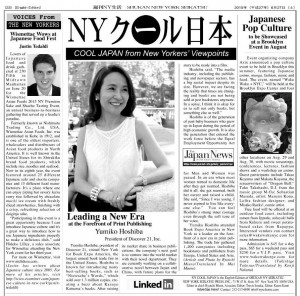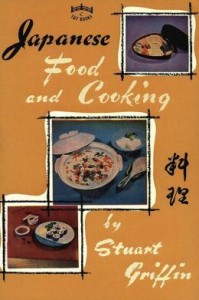JQ Magazine: Nippon in New York — ‘Shin Godzilla,’ New York Comic Con, Ramen Slurpfest, ‘We Are X’
By JQ magazine editor Justin Tedaldi (CIR Kobe-shi, 2001-02). Justin has written about Japanese arts and entertainment for JETAA since 2005. For more of his articles, click here.
The Japan-centric events of the month ahead promise to be as rich and full as autumn itself—brisk and colorful, with a dash of unpredictability.
This month’s highlights include:
Barclays Center, 620 Atlantic Avenue (Brooklyn)
$49, $89
ESL, the world’s largest esports company, brings the East Coast’s largest esports tournament to Brooklyn! This two-day tournament will feature a $250,000 Counter-Strike: Global Offensive competition and a $75,000 Street Fighter V Brooklyn Beatdown offline tournament! In addition to the tourneys, ESL One New York will feature a wide array of activities as part of the main event, including pro player autograph sessions, virtual reality experiences, the ESL Shop, and other fan fest activities.
Sunday, Oct. 2, 7:00 p.m.
DROM, 85 Avenue A
$13 advance, $18 at the door
“I started writing some of the material for the album on my final year on JET,” says New York City-based alum Tony Waldman (Mie-ken, 2005-09), drummer and co-composer for progressive rock quintet Edensong, about the band’s new album, Years in the Garden of Years. “Some of the music is definitely inspired by Japanese RPG game music and references stuff both musically and in the titles of songs.” The band’s self-released 2008 debut The Fruit Fallen was hailed as a “masterpiece” by critics, and helped pave the way for live shows and notable festival appearances throughout North America. Their new release further explores their intricately composed eclectic orchestral rock style, culminating in this special live performance.
Wednesday, Oct. 5, 7:30 p.m. and 9:30 p.m.
Lew Tabackin Trio with special guest Toshiko Akiyoshi
Dizzy’s Club Coca-Cola, Broadway and 60th Street, fifth floor
$40, $25 students
One of the greatest marriages in jazz history, NEA Jazz Master Toshiko Akiyoshi and reed virtuoso Lew Tabackin have been leading and performing in top jazz groups since the sixties. Akiyoshi is known for her challenging and full-textured arrangements that sometimes evoke her homeland, Japan, while Tabackin is recognized for his dedication to showing the full range of possibilities on his instrument—melodically, rhythmically, and dynamically. Together, they lead an eponymous big band of international renown, but this special one-night-only engagement at Dizzy’s will showcase the duo in a more intimate small group setting.
I’ll Make It Myself!: Black Sesame and Pear Muffins
LM (CIR Ishikawa-ken, Anamizu, 2009-11) is the editor of The Ishikawa JET Kitchen: Cooking in Japan Without a Fight. Ze works in international student exchange; writes I’ll Make It Myself!, a blog about food culture in Japan and the US; curates The Rice Cooker Chronicles, a series of essays by JETs and JET alumni on the theme of cooking/eating and being alone in Japan; and admins The JET Alumni Culinary Group on LinkedIn.
Have I told you, dear readers, how much I love Lottie and Doof‘s “Black Sesame and Pear Cake”? When I could get Western pears, I loved making that cake in Japan, where black sesame is a common ice cream and wagashi flavor. I wanted to adapt the flavors of this cake into something smaller, less sweet, and more portable for weekday breakfasts, hence the muffins.
I’ll Make It Myself!: Afternoon Tea x Glico’s “Sweet Love Story”
L.M. (CIR Ishikawa-ken, Anamizu, 2009-11) is the editor of The Ishikawa JET Kitchen: Cooking in Japan Without a Fight. Ze works in international student exchange; writes I’ll Make It Myself!, a blog about food culture in Japan and the US; curates The Rice Cooker Chronicles, a series of essays by JETs and JET alumni on the theme of cooking/eating and being alone in Japan; and admins The JET Alumni Culinary Group on LinkedIn.
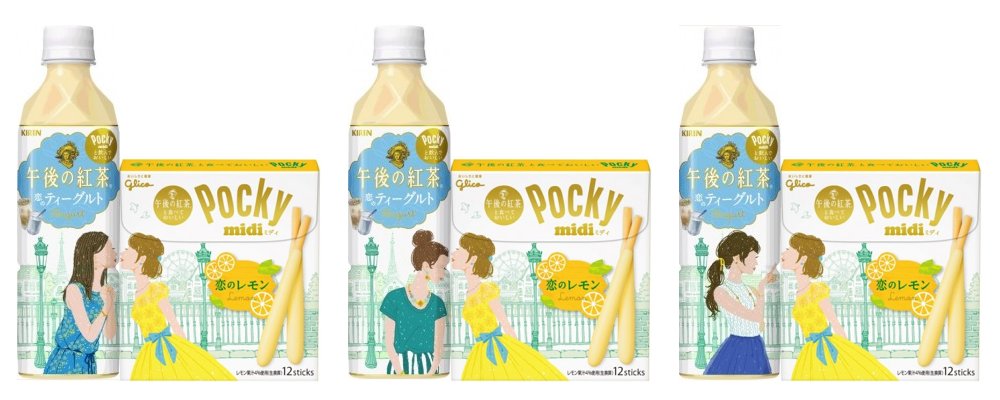
Via @eerrkkyy. Images of Aya, the Pocky character, in a yellow dress and her lips puckered up, lined up with the women characters from the Afternoon Tea bottles, thus appearing to kiss them.
On Feb. 16, 2016, Kirin’s Afternoon Tea brand and Glico’s candy Pocky released their second design/pairing collaboration with Pocky’s “Lemon Love” (恋のレモン) and Afternoon Tea’s “Teagurt” (yogurt + tea) (ティーグルト). Eaten together, the candy and the tea are supposed to taste like rare cheesecake (レアチーズケーキ) a Japanese style of cheesecake that isn’t baked but is stabilized by the addition of gelatin. The package design is also a collaboration: the Pocky boxes feature a woman (Aya) in a yellow dress on one set and a man (Tsubasa) in a yellow vest on the other. Aya and Tsubasa are positioned on the left side of their respective Pocky boxes so you can pair them with the 6 different characters featured on the right side on the drink bottle. There are three men and three women characters on the drink bottles, with one woman character and one man character on opposite sides of the same bottle, so you can turn the bottle to have the character of your choice to face the character on your Pocky box.
At first glance, it looks like Glico and Kirin have created something inclusive, and it’s really, really adorable.
At least until you start reading the copy.
WIT Life #295: Wonder 500 Exhibition
WIT Life is a periodic series written by professional Writer/Interpreter/Translator Stacy Smith (Kumamoto-ken CIR, 2000-03). She starts her day by watching Fujisankei’s newscast in Japanese, and here she shares some of the interesting tidbits and trends along with her own observations.
I arrived in DC yesterday to begin my first State Department interpreting assignment in a while. I’m looking forward to working with my Okinawan group as we travel across the country learning about base-hosting communities in the U.S. I hope that knowing our second half will be in San Diego/Hawaii will make surviving the brutal cold awaiting us in our next stop of Omaha, Nebraska a bit easier…
Getting to spend time in such lovely warm weather while New York is in the middle of winter is a great incentive to be on the road, but the hard part is missing out on cool stuff back home. One such event is the currently running Wonder 500, a collection of Japan’s finest goods, foods and travel experiences. This free exhibit Read More
I’ll Make It Myself!: Crying a Thousand Beautiful Tears into my Tofu
L.M. (CIR Ishikawa-ken, Anamizu, 2009-11) is the editor of The Ishikawa JET Kitchen: Cooking in Japan Without a Fight. Ze works in international student exchange; writes I’ll Make It Myself!, a blog about food culture in Japan and the US; curates The Rice Cooker Chronicles, a series of essays by JETs and JET alumni on the theme of cooking/eating and being alone in Japan; and admins The JET Alumni Culinary Group on LinkedIn.
On my business trip, I had an overnight in Kyoto, and my coworker and I stopped to get lunch at Kyoto Station before going to our hotel. While I’m partial to the “solid tofu” (katatôfu [堅豆腐]) of the Kaga region, I also love Kyoto’s yuba (ゆば, 湯葉), the “tofu skin” and didn’t want to leave the city without eating some. We stopped at Kyotofu Fujino (京豆富「不二乃)」, the Kyoto JR Station’s location of Kyotofu Fujino (note the different kanji: 京とうふ藤野) and ordered a set lunch.
And then proceeded to weep into our tofu.
I’ll Make It Myself: Halloween in Japan (2015): Krispy Kreme’s “Mad for Monsters” Campaign
L.M. (CIR Ishikawa-ken, Anamizu, 2009-11) is the editor of The Ishikawa JET Kitchen: Cooking in Japan Without a Fight. Ze works in international student exchange; writes I’ll Make It Myself!, a blog about food culture in Japan and the US; curates The Rice Cooker Chronicles, a series of essays by JETs and JET alumni on the theme of cooking/eating and being alone in Japan; and admins The JET Alumni Culinary Group on LinkedIn.
Krispy Kreme’s “Mad for Monsters” campaign features four types of doughnuts: Spider Chocolate Custard (スパイダーチョコカスタード), a custard-filled doughnut with a spiderweb design in chocolate icing; Caramel Halloween Jack (キャラメルハロウィーンジャック), a caramel-custard-filled doughnut with a jack-o-lantern design; Maple Milk Franken (メプルミルクフランケン), a square doughnut with a Frankenstein’s monster design and filled with maple custard; and Purple Potato Monster (ムラサキイモモンスター), a yeast ring with purple-sweet-potato icing and three cereal “eyes.”
Justin’s Japan: LuckyRice New York Slurpfest Serves up Ramen Heaven on Earth
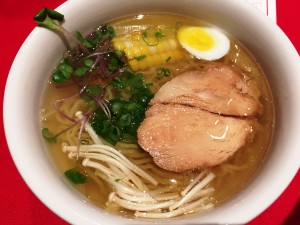
Gator Shio Ramen from Crane Ramen of Gainesville, presented at LuckyRice New York Slurpfest 2015. (Justin Tedaldi)
By JQ magazine editor Justin Tedaldi (CIR Kobe-shi, 2001-02) for Examiner.com. Visit his Japanese culture page here for related stories.
Imagine a place where a variety of regional ramen from around the world is served all in one night. Enter New York Slurpfest 2015, which was held Oct. 22 at Astor Center in Manhattan, featuring dishes from places as diverse as Florida, Fukuoka, Hawaii and Rhode Island—a ramen lover’s dream event.
Slurpfest, which is organized by New York-based Asian culinary event producers LuckyRice, was first held in 2013 and is expected to continue from the looks of last week’s participants, all slurping ramen with smiling faces.
“LuckyRice was founded seven years ago to bring awareness to [Asian] culture, and food is the most universal medium,” said LuckyRice founder Danielle Chang, who rhapsodized about ramen with guests throughout the evening.
“This simple staple has become this glorified chef cuisine,” she added, noting that the amount of ramen restaurants in Japan alone outnumbers every McDonald’s location on the planet.
My evening began with an intriguing dish originating from Crane Ramen in Gainesville called Gator Shio Ramen, which was made with a surprisingly refreshing salt broth topped with corn, greens, quail egg, and alligator tail chashu.
For the complete story, click here.
I’ll Make It Myself!: Halloween Food in Japan (2015): Mister Donut Pon de Shu
L.M. (CIR Ishikawa-ken, Anamizu, 2009-11) is the editor of The Ishikawa JET Kitchen: Cooking in Japan Without a Fight. Ze works in international student exchange; writes I’ll Make It Myself!, a blog about food culture in Japan and the US; curates The Rice Cooker Chronicles, a series of essays by JETs and JET alumni on the theme of cooking/eating and being alone in Japan; and admins The JET Alumni Culinary Group on LinkedIn.
Documenting Halloween in Japan used to be sort of a game to see which companies were marketing the holiday as a seasonal event amidst globalization and marketing gimmicks…. I wanted all the cool doughnuts from the website/ad, but all Ikebukuro had was the jack-o-lantern shaped ones. I also got a kinako raised ring (yeast doughnut) and a chocolate Pon de Ring.
Click HERE to read MORE.
I’ll Make It Myself!: Halloween Food in Japan 2015: Family Mart
L.M. (CIR Ishikawa-ken, Anamizu, 2009-11) is the editor of The Ishikawa JET Kitchen: Cooking in Japan Without a Fight. Ze works in international student exchange; writes I’ll Make It Myself!, a blog about food culture in Japan and the US; curates The Rice Cooker Chronicles, a series of essays by JETs and JET alumni on the theme of cooking/eating and being alone in Japan; and admins The JET Alumni Culinary Group on LinkedIn.
What a perfect time to come to Japan and do some food anthropology! It’s been 10 years since I first came to Japan, and now I’m back for a quick visit, just in time for documenting Halloween. How far we’ve come in ten years from just Baskin Robbins’ Halloween flavors.
I’ll Make It Myself!: Pixelated 1-Up Cake (Mario Bros.)
L.M. Zoller (CIR Ishikawa-ken, Anamizu, 2009-11) is the editor of The Ishikawa JET Kitchen: Cooking in Japan Without a Fight. Ze works in international student exchange; writes I’ll Make It Myself!, a blog about food culture in Japan and the US; curates The Rice Cooker Chronicles, a series of essays by JETs and JET alumni on the theme of cooking/eating and being alone in Japan; and admins The JET Alumni Culinary Group on LinkedIn.

This Nintendo-inspired design is simple to create and works with any round cake–although you won’t want to miss this white-pepper-and-ginger one, which is easily to make in Japan, too.
Japan Local: B-1 Grand Prix in Towada
Mel T (Aomori-ken, 2007-2012) is a Canadian living and working in Towada City, Aomori. For more information about events, sightseeing, restaurants, etc. in Towada City, and around Aomori Prefecture & Japan, visit her blog at http://towada-city.blogspot.com.
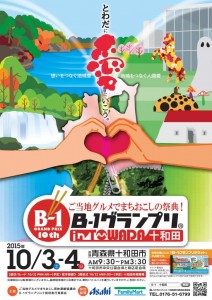 Interested in trying out local “soul foods” from all over Japan?
Interested in trying out local “soul foods” from all over Japan?
Then the 10th B-1 Grand Prix in Towada is the event for you!
From October 3rd-4th, 2015, sixty-two groups from across Japan will gather in Towada (Aomori Prefecture) to promote their respective cities and local “soul foods”. Enjoy soba, udon, ramen, rice bowls, curry, fried foods, grilled meats, and various other dishes originating from Hokkaido to Kyushuu and vote for your favourite group. At the end of the second day, the most popular group–as selected by attendees–will be awarded the Gold Grand Prix Prize (symbolized by giant golden chopsticks :P).
Often misunderstood as standing for “B-grade” (“B級” B-kyuu in Japanese), the “B” in “B-1” actually stands for “brand.” The goal of the B-1 Grand Prix is to revitalize cities and towns through the promotion of their respective local brands. Apart from serving delicious food, participating groups also try to demonstrate their own unique brand of hospitality through performances, etc. This is why attendees of the B-1 Grand Prix are encouraged to vote for their favourite group and not just the best dish.
So if you want to get a taste of many different cities from around Japan, come to Towada for the B-1 Grand Prix.
十和田に愛に行こう!Towada ni ai ni ikou! Come to love Towada!
Official Website (Japanese): http://b-1towada.com/
Click HERE to learn MORE (English)
Justin’s Japan: Wismettac Wows at Japanese Food Fest
By JQ magazine editor Justin Tedaldi (CIR Kobe-shi, 2001-02) for Shukan NY Seikatsu. Visit his Examiner.com Japanese culture page here for related stories.
Lovers of Japanese food and drink gathered at 230 Fifth in Midtown Manhattan on June 20 for the Wismettac Asian Foods 2015 NY Premium Sake and Shochu Tasting Event, an annual business-to-business gathering that served up a foodie’s paradise.
Formerly known as Nishimoto Trading Co., Ltd. USA, Wismettac Asian Foods, Inc. was established in Kobe in 1912, and is one of the oldest importers, wholesalers and distributors of Asian food products in North America. It is well known in the U.S. for its Shirakiku brand food products, which include rice, noodles, and seafood.
Now in its eighth year, the event featured around 25 different Japanese sake and shochu companies and 15 different food manufacturers. It’s a place where one can enjoy piping hot savory katsudon curry rice followed by chocolate mochi ice cream with freshly sliced strawberries, finishing with a crisp, refreshing selection of daiginjo sake.
“Participating in this event is a great opportunity, because I can introduce Japanese culture and it’s a great way to introduce how to use Japanese ingredients properly to make a delicious dish,” said Hideko Lilley, a sales associate for Wismettac attending the New York event for her third year.
For more on Wismettac, visit www.ntcltdusa.com.
I’ll Make It Myself!: Ful Medames with Fresh Fava Beans
L.M. (CIR Ishikawa-ken, Anamizu, 2009-11) is the editor of The Ishikawa JET Kitchen: Cooking in Japan Without a Fight. Ze works in international student exchange; writes I’ll Make It Myself!, a blog about food culture in Japan and the US; curates The Rice Cooker Chronicles, a series of essays by JETs and JET alumni on the theme of cooking/eating and being alone in Japan; and admins The JET Alumni Culinary Group on LinkedIn.

Fresh fava beans one of the delights of spring in Japan. Learn how to measure and prepare them in this Japan-friendly recipe!
JQ Magazine: JQ&A with Merry White on ‘Kissaten: Japanese Cafes Past and Present’
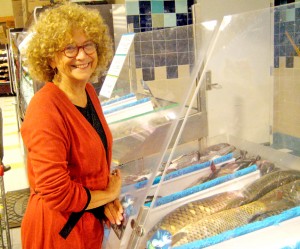
“Japanese coffee standards are the highest—when there is a new varietal on the market, it is often sent to Japan for testing. If a bean can make it in Japan, it can make it anywhere. The quality tasters are very keen, and there are fewer defective beans permitted than anywhere in the world.” (Courtesy of Merry White)
Brewing Up Something at Japan Society
By Alexis Agliano Sanborn (Shimane-ken, 2009-11) for JQ magazine. Alexis is a graduate of Harvard University’s Regional Studies-East Asia (RSEA) program, and currently works as an executive associate at Asia Society in New York City.
When it comes to notable food and drink of Japan, for many “coffee” is not the first thing that comes to mind. Yet, on May 21, Merry (Corky) White, Professor of Anthropology at Boston University, will teach audiences at Japan Society in New York City just how robust their coffee culture is, and how exacting their measurements are. Get ready for something good at Kissaten: Japanese Cafes, Past and Present.
White’s no newbie to food and Japan—it’s been much of the foundation of her professional work. If you look her up on Amazon, you’ll see that she’s been publishing food-related books since the mid-1970s, and regularly offers contributions to publications the world over. Definitely a foodie—and someone who knows her stuff. When not researching coffee and cafes, she’s active teaching about Japanese society, women in Asia, food and culture, and the anthropology of travel and tourism. Check her out on Twitter, where she regularly posts food- and culture-related content.
To whet your appetite for this program, JQ recently caught up with White to learn more about the coffee world in Japan, and what we can expect to hear from this rich presentation.
At your lecture at Japan Society, what do you hope to teach the audience about Japanese coffee culture?
I hope to surprise at least a few people, who may not yet know that Japanese coffee is a well-rooted, well-developed cultural product with a deep history. The coffee experience is also about cafes, koohii hausu, and kissaten, places with a special meaning that have developed over time in Japan. These places have offered people various distinctive experiences, depending on the era. The first ones, in the Meiji period (1868-1912), gave people a window on Europe, decor, clothing, foods—which continued into the Taisho period (1912-1926) when the flappers and lounge lizards demonstrated a new modernity, and the urban cultures were changing to, for example, give women a place in public, too. It was fine for a young woman of good family in the daytime, anyway, to go to a cafe, though probably she might have a chaperone…
Can you describe an iconic Japanese-style kissaten?
Kissaten are now places of memory, as well as ordinary community life. Brown kissa are the “sepia-toned” places where especially middle-aged people (I would say over 60s) like to go for a nice place to sit and get good service and maybe see friends. Young people like them, too, as they often share a love of the past (one they wouldn’t have had themselves) as a retro experience. Kissaten, though, also have more contemporary styles.
I’ll Make It Myself!: Add a Dash of Cultural Imperialism: Japanese Food and Cooking (1956), Part 5
L.M. (CIR Ishikawa-ken, Anamizu, 2009-11) is the editor of The Ishikawa JET Kitchen: Cooking in Japan Without a Fight. Ze works in international student exchange; writes I’ll Make It Myself!, a blog about food culture in Japan and the US; curates The Rice Cooker Chronicles, a series of essays by JETs and JET alumni on the theme of cooking/eating and being alone in Japan; and admins The JET Alumni Culinary Group on LinkedIn.
Part 5 on a series about Stuart Griffin’s Japanese Food and Cooking (1956).
If sushi is the engagement, sashimi, or raw fish, is the wedding. Now is the time to stop dabbling an plunge bolding into what may be regarded as the pièce de résistance, in the accepted French sense, and what some may regard as just the piece to resist, other will regard as the one they cannot resist.
Raw fish, to many foreigners, spells trouble.
“Raw fish!” one can hear them scream, “how could anyone think of eating such a thing?” (36)









